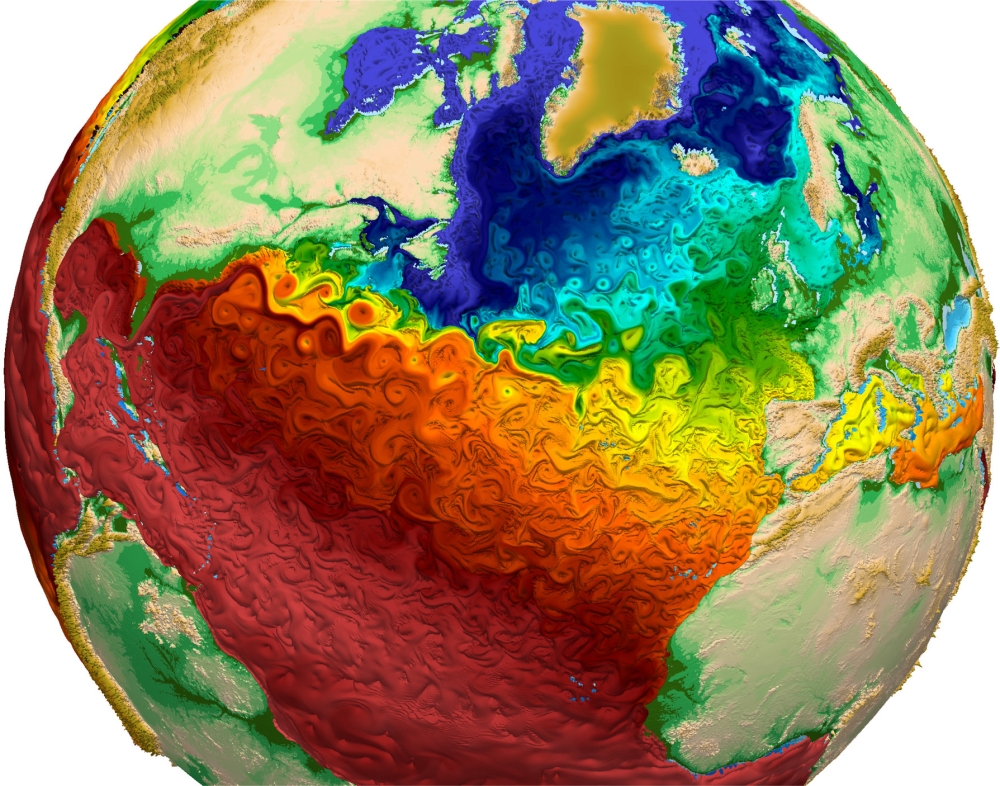Nobel Prize: Complexity, from Atoms to Atmospheres
Updated 7 October 2021.
This year’s Nobel Prize in Physics recognizes efforts to make sense of complexity, whether it be the vagaries of climate or the disorder in glass. Half of the prize went to Syukuro Manabe from Princeton University and Klaus Hasselmann from the Max Planck Institute for Meteorology, Germany, for their work on identifying the factors that drive climate change. The other half was awarded to Giorgio Parisi from Sapienza University of Rome, whose theory of spin glasses has become a template for modeling a wide range of disordered systems, including proteins and financial markets.
Complexity is everywhere we look. Since the 1970s, some physicists have focused on the complexity in spin glasses, whose exotic magnetic behavior emerges from their unique microscopic structure. One example is a metallic alloy of copper with a smattering of randomly placed iron atoms. The iron atoms have magnetic moments, or spins, which can align with one another through interactions. But unlike in solid iron—where the spins line up in a crystalline lattice—the arrangement in a spin glass is disordered and unstable because the interactions vary throughout the material and because each spin can be subject to competing forces. For example, if three spins are equidistant from one another, and each tries to align opposite to its two neighbors, then there is no configuration that allows all three tendencies to be satisfied. This “frustrated” behavior leads to multiple equilibrium states that all have roughly the same energy.
These equilibrium states can be pictured as a large number of valleys of similar depth in an “energy landscape” associated with the spin glass. In 1979, Parisi provided a key tool for mapping this landscape: He defined a new kind of order parameter that isn’t a single value, like those defined in other systems, but instead is a distribution over many values [1]. The traditional example of an order parameter is the magnetism of a ferromagnet whose value is 1 when all of the spins are aligned and 0 when they point in random directions. The magnetism of a spin glass is nearly 0 for all its equilibrium states, so basing an order parameter on magnetism would provide little help in distinguishing those states. But Parisi’s multivalued order parameter provides a way of characterizing the spin glass’ complexity.
In subsequent work, Parisi and others elaborated on the physical basis for the spin-glass order parameter [2, 3]. The theory was built upon the so-called replica method, where you imagine making a carbon copy of a system and letting the two copies evolve separately. Some spins will evolve identically in the two systems, but frustrated spins may wind up pointing differently. Parisi’s order parameter measures the degree to which the replicas diverge. “It will tell you the probability that you find the two systems aligned within a certain degree,” explains disordered systems expert Marc Mézard, director of the École Normale Supérieure in Paris.
Once the order parameter is known, many properties can be calculated. You can determine the entropy of the system and where phase transitions will occur. You can understand how the system will “age”—that is, how it will evolve from one equilibrium state to another. Other researchers have applied Parisi’s model to a wide variety of fields, including structural glasses, granular systems, protein configurations, financial markets, and machine-learning algorithms. “The metaphoric value of spin glasses was so huge that the solution was immediately exported to many other systems,” says complex systems researcher Andrea Cavagna from the National Research Council in Rome.
“It is not easy to recognize theoretical achievements with the Nobel Prize, but here I think that the impact of Giorgio Parisi’s work is clear,” says Mézard. He says that statistical physics aims to explain macroscopic behavior based on microscopic interactions, but disordered systems are a unique challenge. “How do you describe a system where every spin has its own environment?” Parisi showed the way.
This ability to extract predictions from complex systems is at the heart of today’s climate research, which owes much of its foundation to the pioneering work of Manabe and Hasselmann. In 1967, Manabe and colleagues modeled the radiation and convection within the atmosphere, providing a solid link between rising carbon dioxide levels and global temperature increases [4]. In 1976, Hasselmann came up with a way for treating natural variability in climate data [5]. This technique allowed him to identify specific signals in the data—what he called “fingerprints”—associated with various factors that influence climate, including human activity.
Climate expert Gabi Hegerl of Edinburgh University in the UK worked with Hasselmann in fingerprinting the human impact on climate change. She says that Hasselmann and Manabe have both developed models that address fundamental questions about how the climate works and how it changes. “They are two giants in climate science that really shaped and, in some way, started climate science,” Hegerl says.
Climate science and spin-glass modeling both deal with multiple length scales, says Cavagna. He thinks all three Nobel laureates should be commended for zooming in at the right length scale where the complexity could be simplified. “Simplification is really what physics is great at doing,” he says.
–Michael Schirber
Michael Schirber is a Corresponding Editor for Physics Magazine based in Lyon, France.
References
- G. Parisi, “Infinite number of order parameters for spin-glasses,” Phys. Rev. Lett. 43, 1754 (1979).
- Giorgio Parisi, “Order parameter for spin-glasses,” Phys. Rev. Lett. 50, 1946 (1983).
- M. Mézard et al., “Nature of the spin-glass phase,” Phys. Rev. Lett. 52, 1156 (1984).
- S. Manabe and R. T. Wetherald, “Thermal equilibrium of the atmosphere with a given distribution of relative humidity,” J. Atmos. Sci. 24, 241 (1967).
- K. Hasselmann, “Stochastic climate models Part I. Theory,” Tellus 28, 473 (1976).
- G. Hegerl and F. Zwiers, “Use of models in detection and attribution of climate change,” Wiley Interdiscip. Ref. Clim. Change 2, 570 (2011).
More Information
-
2021 Nobel Prize in Physics (Nobel Foundation)





